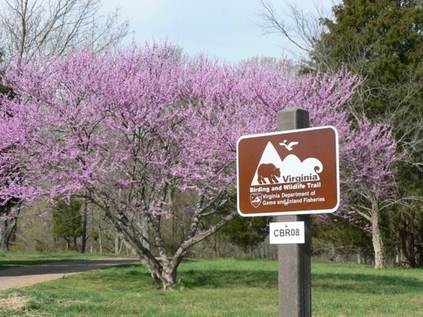DWR Bird and Wildlife Trail Projects
 Virginia Birding and Wildlife Trail signs mark trail sites.
Virginia Birding and Wildlife Trail signs mark trail sites.
About the Projects
The Virginia Bird and Wildlife Trail (VBWT) is a statewide driving trail composed of 65 loops connecting the best sites in Virginia for watching birds and other wildlife. It was established in three phases between 1999 -2004, with the goal of increasing awareness, appreciation and conservation of Virginia’s wildlife and native habitats. When it was completed in 2004, it was the first statewide trail of its kind in the country! All sites are marked with signage and a guide to the trail is available in print and electronically on DWR’s website at http://www.dwr.virginia.gov/vbwt/.
The purpose of these two volunteer projects is to ensure that the VBWT remains a high quality, reliable, relevant, and highly visible Trail program. We have divided the effort into two main projects.
VBWT Education & Outreach
This project entails:
- giving presentations about and promoting the VBWT sites and loops in the local area
- sharing VBWT information and promotional materials at events and/or any relevant opportunities for reaching interested members of the public,
- nominating new VBWT sites that provide high-quality wildlife viewing opportunities and alerting DWR’s Watchable Wildlife staff about sites that your chapter feels should be removed from the Trail.
Please download and read the VBWT Education & Outreach project form for more details.
VBWT Site Visits
This project entails:
- regularly adding bird and wildlife observations to eBird and iNaturalist for each site (at least once a year, but no more than monthly)
- reviewing VBWT loop pages to ensure they are relevant to the area
- documenting site accessibility
- collecting other site information on an as-needed basis.
Please download and read the VBWT Site Visits project form for more details.
How To Get Involved
For either project, chapters (not just individual volunteers) must agree to make a commitment and select one person to serve as the main point of contact for the project in their chapter. The liaison may be the same person for both projects, or different people. Chapters willing to make this commitment should email Michelle Prysby to get started.
The project must be approved at the chapter level in order to be listed among the chapter's approved projects in Better Impact. We have activity templates stored on Better Impact.
For either project, chapters (not just individual volunteers) must agree to make a commitment and select one person to serve as the main point of contact for the project in their chapter. The liaison may be the same person for both projects, or different people. Chapters willing to make this commitment should email Michelle Prysby to get started.
The project must be approved at the chapter level in order to be listed among the chapter's approved projects in Better Impact. We have activity templates stored on Better Impact.
Training and Project Resources
Training Videos
See below for a series of training videos that will walk you through how to submit information to iNaturalist and eBird for the purposes of the Site Visits activity. Watch the videos using the playlist player below, or follow these links to watch each video at video.vt.edu. Note that the videos may refer to uploading data to CitSci.org after entering it into iNaturalist and eBird, but that step is no longer necessary, as the CitSci.org portion of the project was completed and has been discontinued.
Create Accounts on iNaturalist and eBird
Submitting eBird Checklists from a Desktop Computer
Submitting eBird Checklists from a Mobile Device
Submitting iNaturalist Observations from a Desktop Computer
Submitting iNaturalist Observations from a Mobile Device
See below for a series of training videos that will walk you through how to submit information to iNaturalist and eBird for the purposes of the Site Visits activity. Watch the videos using the playlist player below, or follow these links to watch each video at video.vt.edu. Note that the videos may refer to uploading data to CitSci.org after entering it into iNaturalist and eBird, but that step is no longer necessary, as the CitSci.org portion of the project was completed and has been discontinued.
Create Accounts on iNaturalist and eBird
Submitting eBird Checklists from a Desktop Computer
Submitting eBird Checklists from a Mobile Device
Submitting iNaturalist Observations from a Desktop Computer
Submitting iNaturalist Observations from a Mobile Device
